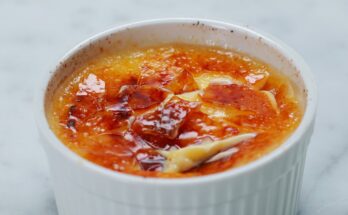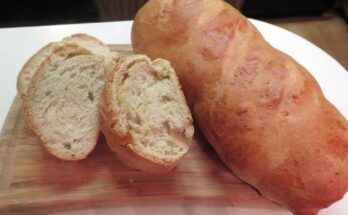Boneless Short Rib Recipe: Boneless short ribs are the ultimate comfort food. They’re rich, meaty, and packed with flavor, making them a favorite for both weeknight dinners and special gatherings. Unlike traditional bone-in short ribs, these are easier to prepare, quicker to cook, and just as tender when made the right way. Whether you’re new to cooking ribs or a seasoned home chef, this recipe will give you a foolproof method to make them melt-in-your-mouth delicious.
In this guide, you’ll not only get a step-by-step recipe but also cooking tips, serving ideas, and flavor variations. By the end, you’ll know exactly how to create a restaurant-quality dish in your own kitchen.
What Are Boneless Short Ribs?
Before diving into the recipe, let’s clear up what boneless short ribs actually are. Many people think they’re just bone-in ribs with the bone removed, but that’s not entirely true. Boneless short ribs usually come from the chuck or shoulder area of the cow, rather than directly from the rib section. This gives them a slightly different texture—still rich and beefy but with a bit more fat marbling that keeps them juicy during cooking.
They’re perfect for slow-cooking, braising, or grilling, and they pair beautifully with bold seasonings. The meat is tougher than a steak, which means it needs longer cooking to become tender—but once it does, it practically falls apart on your fork.
Why Choose Boneless Short Ribs?
So, why should you choose boneless short ribs over bone-in? The answer is simple: convenience and versatility. Boneless cuts are easier to trim, portion, and cook evenly. Since there’s no bone to work around, you get more meat per serving and less waste.
Cooking-wise, boneless short ribs are incredibly versatile. You can braise them low and slow for hours until they’re fork-tender, or you can grill them quickly for a smoky, caramelized flavor. They also soak up marinades really well, making them a great option if you love experimenting with flavors like Korean BBQ or red wine braises.
Another perk? They’re family-friendly. Kids often prefer boneless cuts since they don’t have to fuss with bones, making dinner a little easier for everyone.
Ingredients You’ll Need
Here’s a breakdown of what you’ll need to prepare boneless short ribs:
Core Ingredients
- 2–3 lbs boneless short ribs – trimmed of excess fat
- 2 tbsp olive oil – for searing
- 1 large onion – chopped
- 3 garlic cloves – minced
- 2 cups beef broth – for braising
- 1 cup red wine (optional, for depth of flavor)
- 2 tbsp tomato paste – adds richness
- 2 carrots – chopped
- 2 celery stalks – chopped
- 2 bay leaves
- Salt and black pepper – to taste
Optional Add-Ons
- Fresh herbs (thyme, rosemary, parsley) – for garnish and aroma
- Soy sauce or Worcestershire sauce – for umami depth
- Crushed red pepper flakes – if you want a little heat
These ingredients are flexible. If you don’t have wine, just add more broth. If you prefer sweeter undertones, toss in a splash of balsamic vinegar or even a spoonful of brown sugar.
Step-by-Step Guide to Cooking Boneless Short Ribs
Step 1: Preparing the Meat
Start by trimming any large pieces of fat from your boneless short ribs. While some fat adds flavor, too much can make your dish greasy. Pat the meat dry with paper towels—this helps it sear better.
Step 2: Seasoning and Marinating
Season generously with salt and black pepper. If you have time, let the ribs marinate in olive oil, garlic, and herbs for a few hours or overnight. This step is optional but highly recommended for maximum flavor.
Step 3: Searing for Flavor
Heat olive oil in a heavy-bottomed pot or Dutch oven. Add the ribs and sear on all sides until they develop a deep golden-brown crust. This locks in juices and builds a flavorful base for the sauce. Don’t overcrowd the pan—work in batches if needed.
Step 4: Slow Cooking / Braising Method
Once the ribs are seared, remove them and set aside. In the same pot, sauté onions, carrots, celery, and garlic until softened. Stir in tomato paste and cook for a minute to deepen the flavor. Add red wine (if using) and let it reduce slightly. Then pour in beef broth, bay leaves, and herbs. Return the ribs to the pot, cover with a lid, and let them braise on low heat for 2.5–3 hours until fork-tender.
Step 5: Serving Suggestions
When the ribs are done, remove them from the pot and skim excess fat from the sauce. Serve them with creamy mashed potatoes, buttered noodles, or crusty bread to soak up the rich sauce. Garnish with fresh herbs for a restaurant-style finish.
Alternative Cooking Methods
Not everyone has the time—or patience—for a 3-hour braise, and that’s perfectly fine. Boneless short ribs are versatile enough to be prepared in several different ways. Depending on your kitchen tools and how much time you have, you can choose the method that suits you best.
Oven Method
If you prefer a hands-off cooking approach, the oven is your best friend. After searing the ribs and sautéing the veggies on the stovetop, transfer everything to a Dutch oven or oven-safe pot. Cover tightly with a lid or foil and bake at 325°F (160°C) for about 2.5 to 3 hours. The consistent, even heat of the oven ensures the ribs turn out tender and flavorful without the need for constant checking.
Instant Pot Method
Short on time? The Instant Pot delivers fall-apart short ribs in just over an hour. Start by using the sauté function to brown the ribs and cook your onions, garlic, and tomato paste. Add the broth, wine, and seasonings, then pressure-cook on high for 45 minutes. Allow a natural release for about 15 minutes. This method is perfect for weeknight dinners when you want comfort food without the wait.
Grill Method
For a smoky, charred twist, grilling is an excellent choice. Marinate the ribs overnight in a flavorful sauce—something bold like soy sauce, garlic, brown sugar, and sesame oil works beautifully. Grill over medium-high heat for about 6–8 minutes per side, depending on thickness. While grilling doesn’t give you that braised fall-apart texture, it creates a juicy, slightly chewy rib that pairs perfectly with fresh salads or grilled veggies.
Best Side Dishes for Boneless Short Ribs
The beauty of boneless short ribs lies in their versatility—they pair with so many sides. To complete your meal, consider these tried-and-true options:
Mashed Potatoes
Creamy mashed potatoes are the classic companion. They soak up all that rich sauce, creating the ultimate comfort food combo. Add roasted garlic or a splash of cream for extra indulgence.
Roasted Vegetables
Caramelized root vegetables—like carrots, parsnips, or Brussels sprouts—balance out the richness of the ribs. Roasting brings out their natural sweetness, making them a healthy yet delicious choice.
Rice or Noodles
If you want something lighter, go for fluffy rice or egg noodles. They act as a neutral base, letting the beefy sauce shine. Asian-style ribs especially pair well with jasmine rice or soba noodles.
Fresh Salad
Sometimes, you need something crisp to cut through the richness. A simple green salad with lemon vinaigrette or arugula tossed in balsamic adds freshness and balance.
Tips for Perfect Short Ribs Every Time
Cooking boneless short ribs is straightforward, but a few small details make the difference between good and exceptional results.
- Choose well-marbled ribs. The fat running through the meat keeps it moist and flavorful. Leaner cuts can turn tough and dry.
- Don’t skip the sear. That deep caramelization builds the foundation for the entire dish. Think of it as unlocking the flavor potential of the meat.
- Low and slow is key. Patience pays off. The collagen in short ribs needs time to break down, which is what makes the meat fork-tender.
- Watch your liquid level. Too much broth dilutes flavor; too little can cause burning. The liquid should come about halfway up the meat.
- Rest before serving. Letting the ribs sit for 10 minutes allows juices to redistribute, ensuring every bite is succulent.
Storage and Reheating Tips
One of the best things about boneless short ribs is how well they store and reheat. In fact, many cooks agree they taste even better the next day, once the flavors have melded together.
Refrigeration
Store cooled short ribs in an airtight container with their sauce. They’ll last up to 4 days in the fridge.
Freezing
For longer storage, freeze ribs in heavy-duty freezer bags or containers. They’ll stay good for about 3 months. To prevent freezer burn, try to remove as much air as possible.
Reheating
- On the stovetop: Reheat slowly in a saucepan over medium-low heat until warmed through.
- In the oven: Place ribs in an oven-safe dish, cover with foil, and heat at 300°F (150°C) until hot.
- In the microwave: Use only if you’re short on time. Cover loosely and heat in short intervals to avoid drying out.
Nutritional Information
Boneless short ribs are hearty, indulgent, and undeniably delicious—but what do they look like nutritionally? While they aren’t the leanest cut of beef, they do provide plenty of protein, iron, and other nutrients your body needs. Here’s a general breakdown per 6-ounce serving (without sides, just the ribs and sauce):
| Nutrient | Amount (Approx.) |
|---|---|
| Calories | 420–480 kcal |
| Protein | 35–40 g |
| Fat | 28–32 g |
| Carbohydrates | 4–6 g |
| Fiber | 1 g |
| Iron | 15% DV |
| Vitamin B12 | 35% DV |
Of course, the nutritional content changes depending on your cooking method and ingredients. For instance, using less oil and skipping wine can cut calories, while adding extra veggies boosts fiber and micronutrients.
Boneless short ribs are a nutrient-dense comfort food. They deliver long-lasting energy thanks to their balance of protein and fat. Pairing them with lighter sides like roasted vegetables or salads helps keep the meal balanced.
Common Mistakes to Avoid
Even the best cooks slip up sometimes, but with short ribs, a few mistakes can make or break your dish. Here are some pitfalls to avoid:
- Overcooking on high heat – Short ribs need gentle, low cooking. Cranking up the heat will dry them out before they get tender.
- Skipping the sear – That caramelized crust adds depth and complexity. Without it, your sauce will taste flat.
- Adding too much liquid – You’re braising, not boiling. The liquid should only come halfway up the meat; otherwise, flavors get watered down.
- Rushing the cook time – Collagen takes time to break down. Cutting the process short will leave you with chewy, tough ribs.
- Not skimming fat – Short ribs are naturally fatty. Failing to skim the excess can leave your sauce greasy and heavy.
Keeping these in mind will ensure your ribs turn out tender, flavorful, and perfectly balanced every single time.
Flavor Variations to Try
One of the best things about boneless short ribs is how easily they adapt to different flavor profiles. Here are a few ideas to keep things interesting:
Asian-Inspired Ribs
- Use soy sauce, sesame oil, ginger, garlic, and a touch of honey or brown sugar.
- Garnish with green onions and sesame seeds.
- Pair with jasmine rice or stir-fried noodles.
Classic BBQ Ribs
- Coat ribs in a smoky dry rub (paprika, garlic powder, cayenne).
- Braise with a mixture of beef broth and BBQ sauce.
- Finish with extra BBQ sauce and caramelize under the broiler.
Red Wine-Braised Ribs
- Add plenty of red wine, tomato paste, and fresh herbs like rosemary and thyme.
- Serve with creamy polenta or mashed potatoes.
- This version tastes like something straight from a fine-dining restaurant.
Each variation has its own personality, but all highlight the rich, beefy flavor of the short ribs.
How to Serve Boneless Short Ribs Like a Pro
Presentation can elevate your dish from home-cooked comfort to a gourmet experience. Here are some simple but effective plating tips:
- Use a wide plate or shallow bowl. Place the ribs on top of a base (mashed potatoes, rice, or polenta) and spoon sauce generously over the top.
- Add a pop of color. Fresh parsley, rosemary sprigs, or even microgreens brighten the plate.
- Balance textures. Serve something creamy (like mashed potatoes) with something crisp (like roasted veggies) for contrast.
- Portion smartly. Two pieces of rib per person with sauce is usually enough—let sides complete the meal.
If you’re serving guests, consider bringing the pot to the table family-style. It feels rustic, welcoming, and lets everyone dig in together.
FAQs about Boneless Short Rib Recipe
1. Can I cook short ribs without marinating?
Yes, you can. Marinating enhances flavor, but seasoning generously and slow cooking will still deliver tender, tasty results.
2. How do I make them tender faster?
The Instant Pot is your best option. It cooks ribs to tender perfection in about an hour. Otherwise, patience is key—low and slow wins every time.
3. Can I use bone-in ribs instead of boneless?
Absolutely. Bone-in short ribs actually add extra flavor to the sauce. Just note they may take slightly longer to cook.
4. What’s the best wine for braising?
Dry red wines like Cabernet Sauvignon, Merlot, or Shiraz work beautifully. If you don’t want to use alcohol, replace with extra beef broth plus a splash of balsamic vinegar.
5. How can I make this dish healthier?
Trim excess fat before cooking, use less oil, and load up on vegetables in the braising liquid. Pair with a light salad instead of heavy sides.
Conclusion
Boneless short ribs are the definition of comfort food—rich, hearty, and bursting with flavor. Whether you braise them slowly in the oven, speed things up with an Instant Pot, or grill them for a smoky twist, the result is always a dish that feels special. With the right seasoning, cooking method, and sides, you can transform a simple cut of beef into a restaurant-worthy meal at home.
Now that you’ve got the step-by-step guide, tips, and flavor variations, it’s time to roll up your sleeves and give this recipe a try. Your kitchen will smell amazing, and your family or guests will thank you for it.



